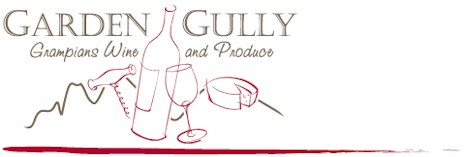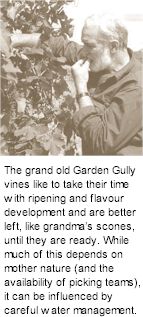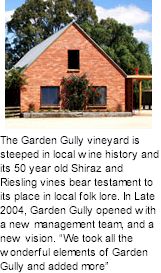


The vineyard produces a limited range of premium wines sourced from the property's old vines and as well as younger plantings. The Shiraz is sensational and the Sparkling Shiraz takes all of us back to those halcyon days of the Great Western Region. The Garden Gully's vignerons are still trying to reshape the grand old vines and repair some of the damage caused by several years of neglect. The strategy is to prune the vineyard as late as possible to minimize the frost risk. Despite the frost and the very small crop at Garden Gully, the vines need frequent watering to maintain vine health.

The new Garden Gully was the brainchild of Sarah and Tom Guthrie, who over a period of months found another four investors to share their vision. Tom and Sarah Guthrie established their 8 acre Grampians Estate vineyard in 1989 on the slopes of the Grampians. The premium wines now being produced and the recognition they have received in wine shows, have given Sarah and Tom the confidence to expand their business and invest in Garden Gully.
Paul Dalkins lives at Great Western where he has his own young vineyard. Paul has worked on vineyards throughout south eastern Australia and New Zealand, and loves working in viticulture in the Grampians. Bruce and Robyn Dalkin own the 35-year-old Westgate Vineyard only a few kilometres up the valley from Garden Gully. When the Dalkins were invited to join the new Garden Gully team, they saw it as an opportunity to provide a cellar door outlet to sell the Westgate Label and also to invest in a piece of the regions history and advance the Garden Gully label which has had years of recognition.
Helen and Bill Francis, together with family members, Lindsay, James and Katharine Mullins, were inspired by the new vision for Garden Gully, having lived for 28 years in Charles Pierlot’s old home overlooking the Salinger vineyards. They produce olive oil from their own olive grove, Great Western Olives. Kate and Mick Connellan are relative newcomers to the Grampians region arriving in Ararat 12 years ago, originally planning to stay just three or four months! Their interest in good food and wine has been nurtured by the Ararat Wine and Food Society, of which Mick has served terms as foodmaster and president. They see Garden Gully as an opportunity to become actively involved in enhancing the region which they have come to love and enjoy.

The Garden Gully Vineyard is steeped in local wine history and its 50 year old vines bear testament to its place in local wine lore. From its early days as the Hockheim Winery established in the 1870s, through its days as a Seppelt vineyard and finally to its current incarnation as Garden Gully, Grampians Wine and Produce, it has always been recognised as a purveyor of fine wines. As Len Evans put it in his ‘Complete Book of Australian Wine’, published in 1990, “Garden Gully is one of the newest wineries in the Great Western region of Victoria, it is, at the same time, part of one of the oldest.”
Salingers operated the vineyard until 1945, when it was sold to Seppelt. The old winery crumbled, but original underground tanks remain. These old tanks, made of cement and bricks are still used today as water storage. In 1984 Seppelt began a rationalisation of their operations at Great Western, which meant a greater commitment to the sparkling white varieties and Seppelt found themselves with some f ine vineyards bearing such varieties as shiraz and Rhine Riesling which they simply didn’t need any more. A group saw the opportunity to broaden their horizons and set up a company called Garden Gully Great Western Vineyards Pty Ltd to buy the vineyards and to make wine.
Garden Gully operated successfully for some 16 years, when the decision was made by the investors to sell the proper ty to allow the team to move on. In late 2004, the five local families who currently operate the winery, interested in seeing the Garden Gully history continue, purchased the property and reopened the cellar door, which had been closed for several years. Garden Gully’s place in local history is exemplif ied by two plaques on the site. The first, unveiled in 1988, is on a stone from the original 100 yearold building. The second plaque was unveiled in 2004 and acknowledges our commitment to re-build and maintain Great Western’s winemaking traditions
